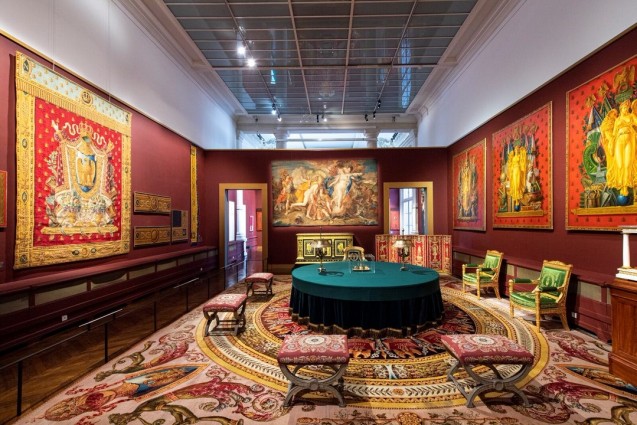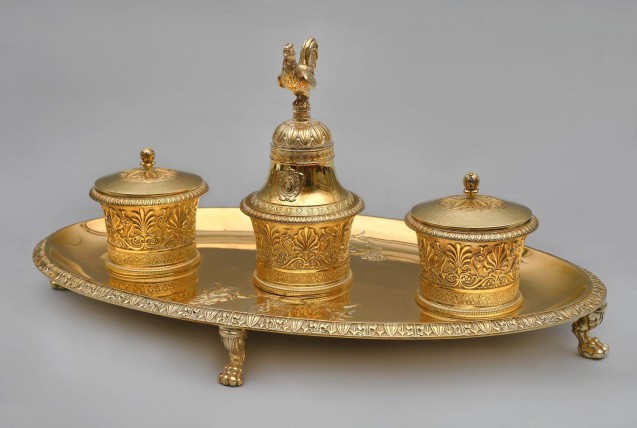This luxurious inkstand (GMLC-624-000) (which before 2021 had never been publicly exhibited) was made for the Grand Cabinet (formal office) of Napoleon I at the Palais des Tuileries by Martin Guillaume Biennais (1764-1843) and delivered there in December 1813. At the same time, the Emperor’s goldsmith supplied an identical copy for the palace of Fontainebleau(exhibited at the exhibition > “A Palace for the Emperor. Napoleon I at Fontainebleau”,14 September 2021 to 4 January 2022. See here for an image).
This inkstand comprises: an oval tray, set on four lion’s feet, originally decorated on one side with the Emperor’s cipher between two cornucopias, and on the other side with the imperial arms between two “renommés” [figures epitomising Fame] holding palms; and three containers – an inkwell, a sand recipient, and a container for the penwiper sponge. Two of the containers have lids, and the one in the centre is topped by a bell with a handle in the form of a rooster.
This ceremonial inkstand was reserved for the Emperor’s use in the signing of official documents. At the Tuileries, Napoleon I exercised most of his sovereign power in the Emperor’s salon or Grand Cabinet. It was here that were held the councils of ministers, audiences with ambassadors, and where great civil servants swore their oaths.

The Grand Cabinet was located on the second floor of the Tuileries palace looking over the Cour d’Honneur, between the Salle du Trône [throne room] and the Galerie de Diane. Its décor had not really changed since the reign of Louis XIV. Unlike the Throne Room, whose layout was decided in 1804, the Grand Cabinet was the room whose furnishings were subject to the most changes of mind and modification.
The Emperor was not satisfied with the “yellow tabac d’Espagne” damask furnishings installed in 1807. In September of that year he asked for tapestried wall hangings, door-hangings and valances from the Gobelins Manufacture, and that the seats should also be upholstered with tapestries from the Gobelins or from Beauvais, and that a carpet be made by the Manufacture de la Savonnerie.
In January 1809, the fabric that had covered the walls was replaced with four tapestries recently made at the Gobelins Manufactory bearing the following mythological scenes: Vénus blessée par Diomède [Venus wounded by Diomedes] (GMTT-220-002) woven from a design by Antoine-François Callet, placed above the fireplace (removed in 1810 when Percier’s new monumental fireplace was created); Hélène poursuivie par Énée [Helen pursued by Aeneas] (GMTT-220-004) after Joseph-Marie Vien, on the long main wall; Zeuxis at Crotone after François-André Vincent in front of the fireplace, and l’Enlèvement de Déjanire [The Abduction of Dejanira] after Guido Reni on the overmantel between the windows. Borders were specially woven at the Gobelins to act as frames. They bore, in alternation, the cipher of the Emperor and the imperial symbols. These tapestries were a temporary solution, awaiting the creation of tapestries based on existing paintings of the military or diplomatic high points of the reign.
Two door-hangings represented respectively the Great French Imperial Coat of Arms (GOB-23-00), and the Coat of Arms of the kingdom of Italy (GOB-551-000), both set against a red ground dotted with bees. These were completed by four other door-hangings bearing allegorical subjects, namely Victory, Fame, the Genius of science and art (GOB-831-001) and the Genius of trade and agriculture.
Some of the woodwork and upholstery of the seats presented to the Emperor in November 1810 did not please him, and they had to be changed (this first ‘rejected’ set of furniture was sent to Rome in 1812 for the Quirinal Palace and is currently held in the palace at Caserta, Italy).
New drawings were made in April 1811, and these were corrected by Denon and David. The carpet specially woven at the Savonnerie (GMT-2079-000), whose design was to be “the most beautiful possible”, was installed that same year. Its subject was the Légion d’honneur and the order’s sixteen cohorts. Curtains of white damask with a trellis pattern of olive branches with bees (GMTC-112-002) were also installed in 1811.
In the end, Napoleon I did not have much opportunity to enjoy the furnishing of his Grand Cabinet at the Tuileries in its ideal state, if indeed it ever reached that state, given the numerous changes of opinion and the modifications requested. The second set of tapestry-covered seats was only installed in March 1813, the vermeil inkstand was delivered in December, and the swivel chair – the last piece to be ordered – was put in place in February 1814, three weeks after the Emperor had left the palace.
During the First Restoration, the omnipresent imperial emblems on the furnishings were removed in a half-hearted way, with only the most visible marks of the government of Bonaparte being modified. After the Hundred Days, however, the symbols of the usurper were to be eradicated almost systematically.
Despite these modifications, Louis XVII and Charles X were to keep most of the decor and furnishings of Napoleon I’s Grand Cabinet. This is true of the inkstand, although the arms of France and the cipher of Louis XVIII replaced those of the Emperor. In 1926, this inkwell was sent to the Elysée Palace. Since that date, it has adorned one or other of the working cabinets of the various French presidents. The choice of this ceremonial inkstand in the Presidential palace can be explained by the presence of the cockerel, a symbol of the French Republic established by the French Third Republic [the system of government established from 4 September 1870 until 10 July 1940].
The Grand Cabinet in the Tuileries palace in its 1814 state has been recreated on the second floor of the Galerie des Gobelins, as part of the temporary exhibition “Napoleon’s Lost Palaces: Tuileries, Saint-Cloud, Meudon“, open until 16 January 2022 (see above photo). The main surviving elements of its furnishings have been brought together, and the workshops of the Mobilier National have restaged the council table with its green silk velvet cloth edged with gold braid and fringe and its green velvet top.
Arnaud Denis, November 2021 (translation RY and PH)
Arnaud is the Inspector of Collections at the Mobilier National [French National Furniture Repository], and one of the curators of the exhibition “Napoleon I’s Lost Palaces: Saint Cloud, Tuileries and Meudon“.
► Bibliography on the Grand Cabinet and its furnishings: Samoyault, Jean-Pierre, “Le grand appartement des Tuileries”, in Palais disparus de Napoléon. Tuileries, Saint-Cloud, Meudon, cat. expo., 2021, p. 135-149.
► This inkstand is on display at the Galerie des Gobelins as part of the exhibition Napoleon I’s Lost Palaces: Saint Cloud, Tuileries and Meudon, from 15 September 2021 to 16 January 2022.


